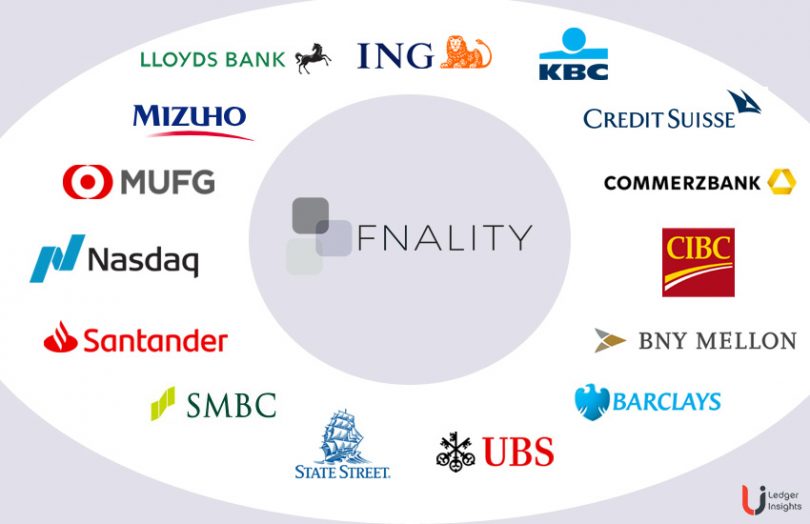Some, including the BIS, classify what Fnality International is building as a wholesale stablecoin, alongside JPM Coin. We spoke to two executives at Fnality, the company behind the enterprise blockchain project formerly known as the Utility Settlement Coin, and both resisted the stablecoin label. Backed by 15 financial institutions, Fnality sees itself as a financial market infrastructure designed for on-chain payments.
With tokenization in full swing, executing payments in the traditional way slows things down, introduces settlement risk and eats into the advantages of blockchain. An on-chain digital currency enables instant settlement with finality or delivery versus payment (DvP).
Executive summary
Fnality Global Payments will comprise a series of local payment systems, with balances backed one-for-one by deposits at central banks with U.S. dollars, Euros, British pounds, Canadian dollars and Japanese Yen targeted as the first digital currencies. As a financial market infrastructure, to get going, Fnality needs central bank approval. The most likely to give initial clearance is the U.S. Federal Reserve, the Bank of England or the European Central Bank.
Fnality is hopeful that the first bank might say yes in Q3 of this year, but there are no guarantees.
Once it has the all clear, it will launch four use cases. These will include interbank payments, liquidity savings mechanisms, margins for OTC derivatives, and a potential integration with the HQLAX digital collateral platform.
JPM Coin v USC
JP Morgan also positions its JPM Coin as a tool for on-chain payments. Another commonality with Fnality is that both are mapped one to one to bank balances. But in the case of JPM Coin, that’s a balance in a JP Morgan Chase account, a commercial bank account. Whereas with Fnality it’s an account at the central bank held by Fnality.
Where many so-called stablecoins can be somewhat vague about token holder rights, in the case of Fnality, the participants will have a collective legal claim on the central bank balance.
And while JP Morgan is massive and has numerous financial institutions as clients, Fnality has the backing of 14 global banks and Nasdaq.
A reliable source told us that JP Morgan was close to participating in Fnality’s £50m Series A last year. And although Goldman Sachs is not an investor, at last year’s SIBOS, an executive spoke very positively on stage about the Fnality project. One could imagine that Goldman might favor using a USC over a JPM Coin, which is the whole point of a consortium approach.
Beyond payments, the second major benefit is the pooling of liquidity. The Fnality payments capability can be used for multiple purposes, rather than having separate silos of money for cross-border payments, collateral management, securities settlement and other purposes.
To appreciate the potential scale of Fnality Global Payments, consider a future where many financial market settlement systems are blockchain-enabled. The Fnality platform could become a key liquidity management tool for bank treasurers who together manage trillions of dollars of cash.
Waiting for the green light
Fnality has been a long time in the making, with the original consortium initiated by UBS and technology startup Clearmatics back in 2016. The hold up is the central bank approval process that Fnality is going through in the U.K., U.S., Europe, Canada and Japan for the five respective currencies. Talking to Olaf Ransome, Industry Solutions Advisor at Fnality, he’s hopeful that it might get its first central bank approval in the third quarter of this year. He’s not sure which one may go first, but it’s likely to be the pound, dollar or euro.
If three central banks gave the green light in a short period of time, Ransome says they have to implement one at a time. And despite having raised a £50 million Series A, that is not enough to get all five currencies live. There will be an independent operating company for each jurisdiction as well as separate blockchains for each currency.
No big bang
Even when Fnality receives the first “go” signal, it will be a cautious approach. “We’re absolutely not trying to do any big bang anythings,” said Ransome. It will start with a scripted test with the 15 banks. He continued: “Put some money in, whether it’s dollars, pounds, or euros in the system, move it around and take it out again just to prove that things connect and they work.”
Continuing the conservative approach, there will be four initial use cases, selected “not because they’re the greatest use cases ever, and we’re not going to blow the roof off in terms of either volume or value,” said Ransome. “But they’re things that we’re pretty certain we can do, whether it’s dollars, pounds, or euros first. And things we can do even without having to have all 15 of our banks do the same thing on the same day,” said Ransome.
Four use cases
An early case will be interbank payments. “Not because we’ve got better route to do it, but simply to prove that things work,” said Ransome. When asked whether Fnality would take some transactions away from forex central counterparty CLS, Ransome was keen to emphasize that Fnality is not aiming to compete with incumbents. The purpose is to enable on-chain payments.
The next use case is intercompany payments between group companies within a bank. This is both relatively easy to implement and also tests liquidity savings mechanisms (LSM). Before delving into LSMs, it’s worth stepping back and noting the pros and cons of instant settlement.
Since 1992, securities settlement in Switzerland via the SECOM system has used instant payments with the same pool of cash as the main interbank payments system (SIC). Historical statistics show that on a normal day, a Swiss franc is turned over 50 times a day, demonstrating the benefits of instant settlement combined with pooling liquidity.
In contrast, U.S. securities clearing organization DTCC wrote a paper about how instant settlement could potentially increase liquidity requirements. That’s because if you made all your payments at the end of the day, you might only need a net half a million based on incoming and outgoing money. But at any point during the day for a single payment settled instantly, you could need as much as $2 million or more, which results in a higher liquidity requirement. But combining instant settlement with pooling and liquidity savings mechanisms help to address this issue.
Liquidity savings mechanisms
LSMs can involve queueing payments, making them dependent on incoming payments as well as enabling netting.
“In a particular asset class or activity class like payments, you’ve got lots and lots of payments for a certain value date between counterparts,” said Ransome. “If you can collect that information up in the right place in advance, you can look through it and say, well, actually, A’s paying B’s, paying C’s, paying A. So that all amounts to nothing or a small net amount.”
He continued: “The way we’re doing it is an advance on what’s done today. Because today, any liquidity savings mechanisms are down in the RTGS (real time gross settlement) systems, and that’s after correspondent banks have had their credit process. So it doesn’t help intraday credit and unsecured credit one iota when the RTGS systems do it. We can be a little bit smarter.”
Derivatives and HQLAX
The third use case relates to the market for OTC derivatives. The notional value of outstanding OTC derivatives was $558 trillion as of June 2019 (source: BIS). It’s also a particularly interesting market because the sector is adopting standards published by industry body ISDA, which have been converted into smart contracts. And they’re starting to get adoption. So it’s a massive on-chain friendly marketplace.
Apart from the initial margins for derivatives, as prices move, the margin variations are painful to manage. Ransome noted that if “you’ve got your money in a smart contract, you can effectively put some conditions around it,” he said. This “will enable cash in the form of what we have inside Fnality to be used to meet margin requirements and that’s quite good for the banks because it avoids the hassle of doing a lot of complex collateral management.”
Additionally, the Uncleared Margin Rules, which have been introduced gradually since 2016, are drawing even more businesses into their scope from September.
The final use case is to integrate the digital collateral platform HQLAX to enable delivery versus payment. At the beginning of this year, banks around the world held $13 trillion in High-Quality Liquid Assets (HQLA) such as government securities, bonds and equities. To comply with legislation, banks constantly need to rebalance their portfolios and do so by swapping assets with other banks. Rather than moving the assets between custodians, with HQLAX there’s a digital collateral record (DCR), and the transfer happens on-chain, thereby enabling intraday swaps.
Sometimes, instead of swapping collateral, there may be a desire to swap for cash, which is where Fnality could help. But the timing of this use case will depend on whether the schedule of the two startups overlap. Two months ago, HQLAX‘s CEO Guido Stroemer told Ledger Insights: “The idea of doing something potentially with Fnality is definitely something that we’re open to. I think that would be kind of a cool thing to be able to engage in a swap between a USC and a DCR (digital collateral record), but at this stage, it’s not part of our immediate plan.”
As the roadmap comes clear, the big question remains: what happens if a central bank releases a central bank digital currency?
What about central bank competition?
Central bank digital currencies (CBDC) are a hot topic at the moment. Since the launch of Libra, the agenda has accelerated, but the focus has shifted to retail CBDC, and a little away from wholesale CBDC. ECB Board member Yves Mersch recently noted that a wholesale CBDC is not a fundamental change because it’s the same set of participants. But the ECB’s focus is currently on retail.
The resistance to the stablecoin label became clear from Ransome’s comments: “What Libra has done is it has accelerated the need to be seen to allow something. Because what you’ve got at the moment is a bunch of stablecoin ideas floating around.”
He continued: “My best analogy is that stablecoins are what happens when you ban everything like the prohibition in the twenties and thirties. The prohibition led to moonshine and people making different forms of Homebrew alcohol. That’s kind of what stablecoins are.”
Ransome shared this thoughts on a wholesale CBDC. He said the central banks could do it, but it would require interfacing with many more financial institutions as well as multiple business platforms. And that’s not part of the central bank DNA.
We asked Philip Middleton, the Deputy Chairman of the central bank think tank OMFIF about a wholesale CBDC. “I don’t think there will be a wholesale bank digital currency (soon),” said Middleton. “I don’t think that’s the number one priority. There are one or two projects going on to look at the potential of that to improve the national equivalents of RTGS. I’m not sure that’s going to happen any time soon and I think retail (CBDC) has come back into the forefront.”
Ransome concurred: “If one of the key ones (central banks) signal that they were going to do this instead, we’d sit up and take notice. So far, that hasn’t happened.”
Check back tomorrow for details about the mechanics of how Fnality works.






